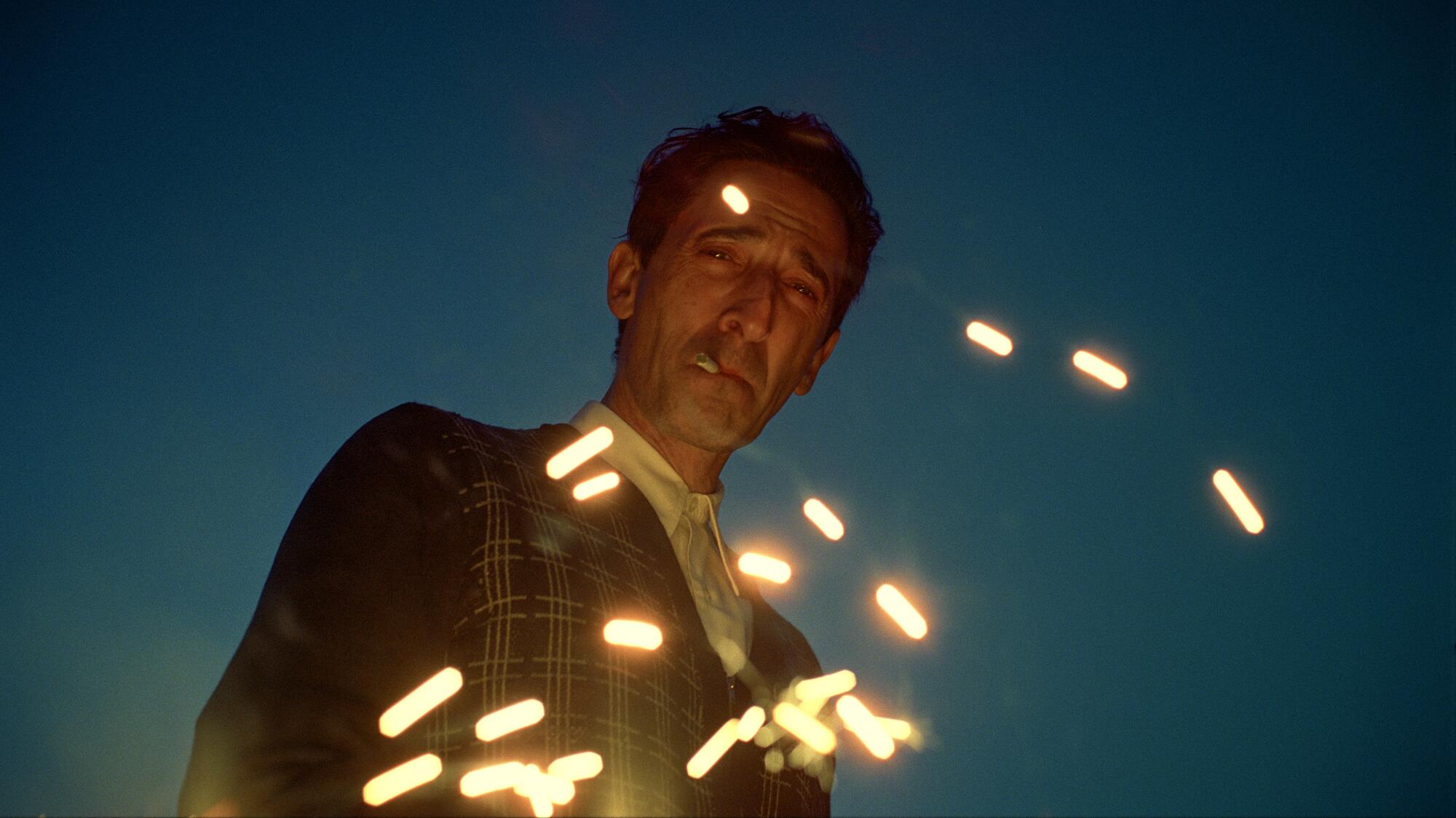Entertainment
Oscars 2025: The five leading best picture contenders and how they might win

We’re heading into the early stretch of awards season where voters are about to embark on a long holiday weekend, give thanks and sift through a topsy-turvy world in which it’s the Dallas Cowboys and not the Detroit Lions who can be safely ignored on the Thanksgiving Day football schedule.
And still … no best picture front-runner. In fact, it’s easier to knock holes in the cases for the most prominent contenders than to argue why it’s plausible they might win.
Still, some movie has to win the Oscar. I do wonder if we’ll look back on this time in a few weeks, slap our foreheads and think, “Of course, ‘Anora’ was always going to win,” because by that point it had swept through various precursors. Right now, though, that’s as hard to imagine as the Cowboys making the playoffs. Or Jerry Jones building a stadium where sunlight isn’t an enemy.
Just for fun, let’s run down the five leading contenders, the movies that will head the field of 10 nominees. Maybe we can convince ourselves that we’re missing something. Or who knows, maybe we are missing something.
Mikey Madison and Mark Eydelshteyn in “Anora”
(Neon)
“Anora”: It starts with the letter A, so it’s at the top of the list. Also: It’s arguably the best of the movies here, likely to win best picture from the Los Angeles or New York film critics’ groups, with writer-director Sean Baker taking some honors as well. It’s also an indie hit, topping $10 million, and, judging from the conversations I’ve had with academy voters, it has left most everyone who has seen it more than satisfied.
Ostensibly, “Anora” is about a stripper who moonlights as a sex worker and ends up marrying one of her clients, the irresponsible son of a Russian oligarch. But it’s many movies in one — a screwball comedy, a tense reckoning with reality, a story of wealth and power, a tender love story. There’s humor and sadness and terror, sometimes in the same scene. It has a star turn from Mikey Madison, who might just win the lead actress Oscar. And there’s an utterly surprising, deeply soulful supporting performance from Yura Borisov, playing Igor, a hired goon who comes to love the title character almost as much as we do. He’s the movie’s secret weapon.
Is there a precedent for a movie about a sex worker winning best picture? You remember Joe Buck, right? (Not the ubiquitous sports announcer.) “Midnight Cowboy” took the Oscar, and it had an X rating. And we’ve come a long way in the last 55 years. OK … we’ve also regressed in some respects too. But “Anora” could very well be the movie to beat.

Adrien Brody in “The Brutalist.”
(A24)
“The Brutalist”: It’s 3 hours and 35 minutes long. It’s in 70mm. It has a built-in intermission, complete with a handy clock counting down the remaining time. Yes, Brady Corbet’s “The Brutalist” is a lot — but in a good way. Not like, say, “Babylon.” This is a movie I anticipate seeing again. It’s a big swing that mostly connects, a film with much to say about the immigrant dream at a time when the immigrant experience is very much in the national conversation.
“The Brutalist” is an event movie made for anyone who obsesses over their Letterboxd account. But it’s also an intimate story about a Holocaust survivor and brilliant architect who possesses a singular vision. So, though I wouldn’t recommend doing this, Oscar voters could watch it on the academy portal over the course of a couple of nights. It’d work. And they’d know exactly when to break up the viewing. Thanks, Brady Corbet! (No, seriously, thanks. “The Brutalist” is a stunning achievement.)

Isabella Rossellini stars as Sister Agnes in “Conclave.”
(Focus Features)
“Conclave”: I enjoyed “Conclave” when I caught its premiere at the Telluride Film Festival. We need more movies like “Conclave,” pulpy, impeccably made crowd-pleasers starring scene stealers like Ralph Fiennes and Stanley Tucci and Isabella Rossellini. In fact, you may be old enough to remember when there’d be dozens of these sleek melodramas geared toward grown-ups. That it has found an audience makes me happy, even if its story of the schemes involved in electing a new pope feels a bit slight and silly to take it too seriously as a movie that could win best picture. And that ending? Hoo-boy. It did get people talking, but maybe not in the ways that the filmmakers would appreciate.

Karla Sofía Gascón in “Emilia Pérez.”
(PAGE 114 – WHY NOT)
“Emilia Pérez”: I wrote about “Emilia Pérez” last week, calling it a lock for international feature, owing to the fact that it’s likely to pull in several nominations and a lot of people genuinely like it. But also: Some people really hate it, and they’re not shy about making their feelings known. It seems like there isn’t a group of people not offended by Jacques Audiard’s musical soap opera about a Mexican cartel boss looking to transition to a woman. Trans activists feel the movie is dismissive, as do many people who care about Mexican culture. As do many people devoted to Selena Gomez, who plays the cartel boss’ wife and has to say some truly awful dialogue. To sum up: It’s polarizing. And divisive movies don’t often go on to win the best picture Oscar.

Cynthia Erivo is Elphaba and Ariana Grande is Glinda in “Wicked.”
(Universal Pictures)
“Wicked”: Here’s a movie that you may have heard a little something about. It’s the film adaptation of the Broadway musical, with Cynthia Erivo playing Elphaba, later known as the Wicked Witch of the West, and Ariana Grande doing light comedy as Glinda. It’s a story of women coming into their own and bonding over magic. You’ve probably already bought tickets to it.
The critics were kinder to “Wicked” than I thought they’d be, and guild audiences have greeted it with enthusiastic standing ovations. It figures to do well with fraudulent awards shows like the Golden Globes and Critics Choice Awards, meaning, at least in the case of the Globes, it’ll get some good airtime. Its blunt, allegorical references to fascism figure to play well postelection, but kids will like it too! Its biggest hurdle is that it’s the first entry of a two-part movie, just half the story. It’s the best half, from what I gather. But many voters will resist jumping the gun.

Movie Reviews
Movie review: A24’s “Marty Supreme” is a mixed bag of humor and intensity

Josh Safdie’s “Marty Supreme” arrives with all the energy and confidence of an aspiring athlete – even one of the table tennis variety.
The film is packed with vivid period detail and striking cinematography that brings 1950s New York to life. On a purely technical level, the movie succeeds. It’s visually inventive, rhythmically paced and often laugh-out-loud funny.
The plot is also engaging, moving at a fast pace to keep up momentum for over two hours. Safdie builds a world where table tennis is more than a game; instead becoming a stage for obsession, ego and ambition. Even as the story dips further and further into chaos, the narrative stays entertaining and unpredictable enough to keep audiences invested.
But as strong as the filmmaking is, the movie’s impact is limited by its abrasive lead. Timothée Chalamet’s Marty Mauser is undeniably watchable, yet consistently unlikable. His selfishness, impulsive decisions and willingness to steamroll everyone around him creates a major disconnect between Mauser and the audience.
Chalamet’s performance is committed and his intensity drives several of the film’s most engaging scenes. Still, it is difficult to root for a character who rarely shows the vulnerability or growth needed to anchor a story this ambitious. For many viewers (myself included), that emotional detachment will shape the entire experience.
The film’s tone may also catch audiences off guard. For a movie centered on table tennis, “Marty Supreme” is extraordinarily vulgar. Its R rating is well earned, with explicit sexual content, coarse language and several violent scenes that land with surprising force. From consensually dubious spanking scenes to Holocaust jokes, the film more than toes the line between bold and unsettling. The contrast between the lightness of the sport and the heaviness of the film’s content is intentionally jarring, but the shock factor can overshadow the story’s strengths.
Even so, “Marty Supreme” remains a compelling watch. Safdie’s direction is inventive, the pacing is tight and the supporting cast (including Gwenyth Paltrow and Tyler, The Creator) bring welcome depth to the film’s darker impulses.
The result is a movie that is engaging and frequently funny – but also brash and not particularly easy to love.
Whether viewers leave impressed or unsettled will depend on their tolerance for its unlikable hero and its unexpectedly graphic approach. For all its craft and confidence, “Marty Supreme” is the kind of film that invites debate and, for some, a fair amount of discomfort.
If nothing else, it proves that a table tennis movie can surprise you – for better and for worse.
“Marty Supreme” is set for a public release on Dec. 25, with specific times varying by theatre. If you are interested in attending a showing, consider taking advantage of discounted AMC tickets, available for reservation through the Center for Leadership and Engagement here at Simmons.
Entertainment
‘South Park’ creators clash with performers at their Colorado restaurant

“South Park” creators Matt Stone and Trey Parker, who this summer landed one of the richest TV deals ever, are being called Scrooges by performers at their Casa Bonita restaurant near Denver.
In late October, the performers, including the famed cliff divers, went on a three-day strike, citing unsafe working conditions and stalled negotiations over their first contract. The performers voted unanimously to unionize with Actors’ Equity Assn. a year ago.
The strike ended when the restaurant’s management agreed to bring in a mediator to assist in the negotiations.
But the standoff has continued, prompting Actors’ Equity to take out an ad in the Denver Post this week that depicts a “South Park” cartoon-like Parker and Stone awash in hundred-dollar bills while their staff, including a gorilla and a person clad in a swimsuit, shivers outside in the Colorado cold.
The union said its goal is to prod the star producers to resolve the labor tensions by giving about 60 Casa Bonita performers, including magicians and puppeteers, a pay increase and other benefits along with their first contract.
A full page ad is running in the Denver Post on Dec 24.
(Actors’ Equity Association)
Other Casa Bonita workers voted earlier this month to join the International Alliance of Theatrical Stage Employees Local 7.
“At Casa Bonita, we value all of our team members and their well being,” the restaurant management said in a statement. “We are negotiating in good faith with our unionized team members in the hopes of concluding fair collective bargaining agreements.”
Parker and Stone declined to comment through a spokesperson.
The pair, who also created the hit Broadway play “The Book of Mormon,” rescued the kitschy, bright-pink Mexican-themed eatery in Lakewood, Colo., from bankruptcy in 2021 and have since plowed more than $40 million into the restaurant to upgrade and correct unsafe electrical, plumbing and structural issues after the facility had fallen into disrepair.
For “South Park” super-fans, the venue has become something of a mecca since first being featured in the seventh season of the long-running Comedy Central cartoon.
In that episode, Cartman flips out when Kyle invites Stan, Kenny and Butters Stotch to his birthday party at Casa Bonita (not Cartman), where they are serenaded by the restaurant’s ubiquitous mariachi bands.
Along with legions of other kids who grew up in Colorado, Parker and Stone fondly remember making the trek to the Casa Bonita of their 1980s youth. Restoring the restaurant has become a passion project for the writers, a journey that became grist for a documentary, “¡Casa Bonita Mi Amor!,” which streams on Paramount+.
In July, Paramount managers were eager to tie up loose ends to facilitate the company’s sale to David Ellison’s Skydance Media and RedBird Capital Partners. The incoming management team also became involved in the protracted negotiations to strike a new deal with Parker and Stone’s production company, Park County, to avoid having the situation unravel, possibly tripping up their corporate takeover.
Paramount ultimately agreed to extend the overall deal for Park County as well as lock up the show’s exclusive global streaming rights for $300 million a year over five years. Until this year, the show streamed exclusively on HBO Max.
The overall deal is slated to bring Parker and Stone’s firm $1.25 billion through 2030.
As part of the pact, the team agreed to create 50 new “South Park” episodes for Paramount. The series has enjoyed a ratings bounce and increased cultural resonance this year as it routinely roasts President Trump.
Actors’ Equity, which also represents Broadway performers, is seeking pay raises for its members at Casa Bonita. Union representatives said performers’ wages there average $21 to $26 an hour.
“Matt and Trey have become fabulously wealthy by pointing out the hypocrisy of rich and powerful people,” said David Levy, communications director for Actors’ Equity. “And now they are behaving exactly like the people they like to take down.”
Movie Reviews
Movie Review 2025 with 11 Films of the Year
Image: Wicked: For Good – Movie Poster
Another year is drawing to a close, and it’s time for our cinema review! In 2025, we saw many franchises return to the big screen, along with sequels to cult classics and new adaptations of legendary stories. From sci-fi and horror to musical adaptations, a wide range of genres offered fresh releases. Whether all of it was truly great is for everyone to decide individually – here is our trailer recap!
While Disney continues to push its live-action remake strategy (Snow White, Lilo & Stitch), Pixar at least delivered a brand-new animated feature with Elio.
When it comes to video game adaptations, several titles were released this year – most notably the Minecraft adaption A Minecraft Movie starring Jack Black and Jason Momoa, the second installment of Five Nights at Freddy’s, and the Until Dawn film, which was heavily criticized by the community.
In Germany, Bully Herbig delivered a sequel to his comedy Der Schuh des Manitu with Das Kanu des Manitu, bringing the characters from one of his most successful films back to the big screen.
Just before Christmas, James Cameron launched the third part of his hit film series Avatar. Sequels also arrived for Jurassic World, the DCU, the Conjuring universe, and the popular animated film Zootopia.
Director Guillermo del Toro took on a new adaptation of the absolute sci-fi horror cult classic and novel by Mary Shelley: Frankenstein has now been brought back to life by the creator of films such as Pacific Rim and The Shape of Water.
When it comes to adaptations, arguably the most popular musical of the year: with Part 2, the Wicked hype has returned once again.
-

 Iowa1 week ago
Iowa1 week agoAddy Brown motivated to step up in Audi Crooks’ absence vs. UNI
-

 Maine1 week ago
Maine1 week agoElementary-aged student killed in school bus crash in southern Maine
-

 Maryland1 week ago
Maryland1 week agoFrigid temperatures to start the week in Maryland
-

 New Mexico1 week ago
New Mexico1 week agoFamily clarifies why they believe missing New Mexico man is dead
-

 South Dakota1 week ago
South Dakota1 week agoNature: Snow in South Dakota
-

 Detroit, MI1 week ago
Detroit, MI1 week ago‘Love being a pedo’: Metro Detroit doctor, attorney, therapist accused in web of child porn chats
-

 Health1 week ago
Health1 week ago‘Aggressive’ new flu variant sweeps globe as doctors warn of severe symptoms
-

 Maine1 week ago
Maine1 week agoFamily in Maine host food pantry for deer | Hand Off



















